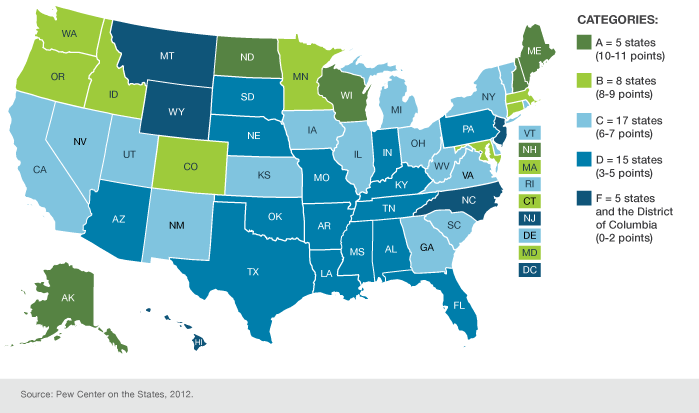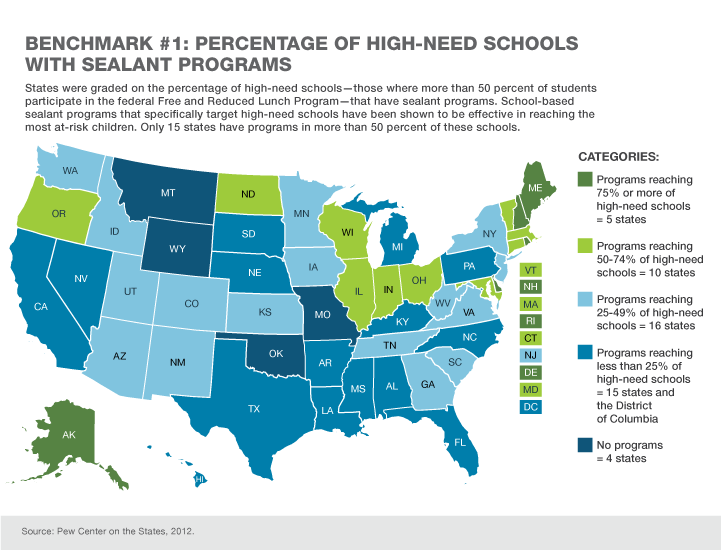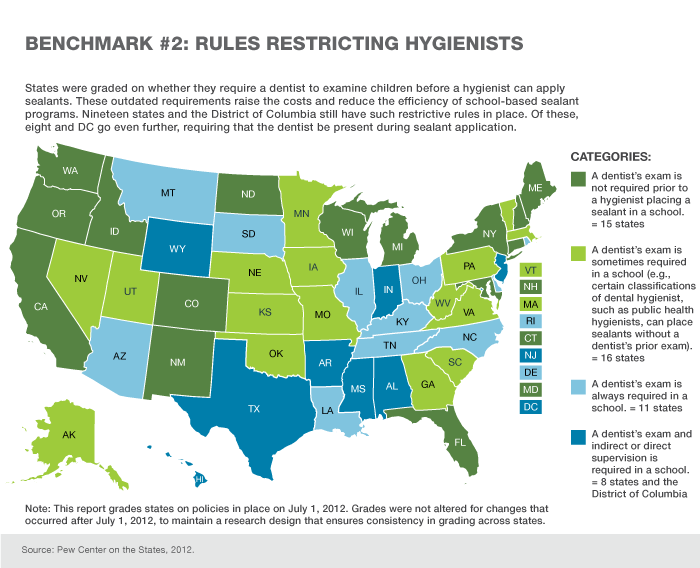Falling Short: Most States Lag on Dental Sealants
QUICK SUMMARY
Pew's 50-state report finds that most states are not doing enough to use a proven strategy for preventing tooth decay, unnecessarily driving up health care costs for families and taxpayers.
Introduction: Grading the States
In both 2010 and 2011, the Pew Children's Dental Campaign released reports grading all 50 states and the District of Columbia on children's dental health, relying on eight evidence-based policies that cover prevention, financing, and workforce issues. However, this year, Pew's 50-state report focuses on prevention, examining states' efforts to improve access to sealants for low-income kids.
Pew's grades are based on four indicators that should be a key part of any state's prevention strategy:
- having sealant programs in high-need schools,
- allowing hygienists to place sealants in school-based programs without requiring a dentist's exam,
- collecting data regularly about the dental health of school-children and submitting it to a national oral health database, and
- meeting a national health objective on sealants.
Overall State Grades
In the map below, states were given specific points for each benchmark, and grades—on a scale of A to F—were based on the total points earned. Learn more about how each state performed in our state fact sheets.

Pew's assessment reflects the states' policies that existed as of July 1, 2012.
REPORT CONTENTS A
Key Findings
Although a number of states are making progress, most of them have a great deal of work to do if they intend to make prevention a priority. Indeed, 40 percent of all states earned a grade of D or F on Pew's benchmarks:
- Thirty-five states and the District of Columbia do not have sealant programs in a majority of high-need schools—those with a high proportion of children most at risk of decay. Unfortunately, four states have no programs in these schools.
- Nineteen states and D.C. still maintain a regulation that restricts hygienists' ability to provide sealants to more children. This outdated rule requires a dentist to examine a child before a hygienist can place a sealant, ignoring the evidence showing this prerequisite is unnecessary. Even states that have passed laws to remove these barriers need to take additional steps. For example, Arkansas removed this restriction in 2011, but the state Board of Dentistry has not yet released regulations to implement this law.
- Forty states and D.C. could not confirm that they had reached at least 50 percent of their children with sealants. This is the minimum threshold established by Healthy People 2010, a national set of disease-prevention objectives that were developed by federal health officials.
- Collecting recent data on tooth decay and other dental health measures is essential for states to make informed and strategic policy decisions. Yet 19 states and D.C. did not submit data from within the past five years on school-aged children to the National Oral Health Surveillance System (NOHSS), a database that enables policy makers to identify trends and assess progress.
- Only five states earned an A, and only two of them (Maine and New Hampshire) received the maximum points possible. Yet, even in these five states, there is room for improvement because thousands of children who are most at risk for decay are not receiving sealants.
- Eight states received a B. Of these states, five failed to meet the Healthy People 2010 objective and half did not have sealant programs in a majority of high-need schools.
- Seventeen states earned C grades, and another 15 received D's. The D states have significant room for improvement.
- Five states—Hawaii, New Jersey, Montana, North Carolina, and Wyoming—and the District of Columbia earned an F. They are lagging far behind in prevention efforts.
Learn more from our 50-state fact sheets.


REPORT CONTENTS B
What Are Sealants?
Dental sealants are clear plastic coatings that take only a few minutes to apply to the chewing surfaces of permanent molars, the most cavity-prone teeth.[i]The coatings act as a barrier against decay-causing bacteria.[ii]
Sealants can be placed following a visual assessment of the teeth to make sure they are not placed on any extensive decay.[iii]After the molars are cleaned and prepped, the sealant material is painted onto the enamel, where it bonds directly to the tooth and quickly hardens.[iv]
Usually, sealants are first placed on children's teeth while they are in the 2nd grade, shortly after their permanent molars appear.[v] In addition to protecting a healthy tooth, sealants also can prevent a cavity from forming when applied during the early stages of tooth decay.[vi]
The CDC and the American Dental Association's Council on Scientific Affairs have cited a number of studies that recognize sealants as one of the most effective preventive strategies.[vii] Schools are an ideal place to reach students at high risk for cavities. School-based sealant programs have been associated with reducing the incidence of tooth decay by an average of 60 percent.[viii]
[i] Centers for Disease Control and Prevention. (2009). Dental sealants. Retrieved March 6, 2012, from http://www.cdc.gov/OralHealth/publications/faqs/sealants.htm; American Dental Association. Oral health topics: Dental sealants. Retrieved April 16, 2012, from http://www.ada.org/en/member-center/oral-health-topics/dental-sealants
[ii] Centers for Disease Control and Prevention. (2009). Dental sealants. Retrieved March 6, 2012, from http://www.cdc.gov/OralHealth/publications/faqs/sealants.htm
[iii] Gooch, B. F., Griffin, S. O., Gray, S. K., Kohn, W. G., Rozier, R. G., Siegal, M., et al. (2009). Preventing dental caries through school-based sealant programs: Updated recommendations and reviews of evidence. Journal of the American Dental Association, 140(11), 1356–1365; Fontana, M., Zero, D. T., Beltrán-Aguilar, E. D., & Gray, S. K. (2010). Techniques for assessing tooth surfaces in school-based sealant programs. Journal of the American Dental Association, 141(7), 854–860.
[iv] American Dental Association. Oral health topics: Dental sealants. Retrieved April 16, 2012, from http://www.ada.org/en/member-center/oral-health-topics/dental-sealants
[v] N. Carter, American Association for Community Dental Programs, & National Maternal and Child Oral Health Resource Center. (2011). Seal America: The prevention invention, Table 1, Second Edition, Revised. Retrieved March 15, 2012, from http://www.mchoralhealth.org/seal/step1.html; Association of State and Territorial Dental Directors. (2003). Best practice approach reports: School-based dental sealant programs. Retrieved March 26, 2012, from http://www.astdd.org/school-based-dental-sealant-programs/#two
[vi] Beauchamp, J., Caufield, P. W., Crall, J. J., Donly, K., Feigal, R., Gooch, B., et al. (2008). Evidence-based clinical recommendations for the use of pit-and-fissure sealants: A report of the American Dental Association Council on Scientific Affairs. Journal of the American Dental Association, 139(3), 257–268; Tellez, M., Gray, S. L., Gray, S., Lim, S., & Ismail, A. I. (2011). Sealants and dental caries: dentists' perspectives on evidence-based recommendations. Journal of the American Dental Association, 142(9), 1033–1040.
[vii] Truman, B. I., Gooch, B. F., Sulemana, I., Gift, H. C., Horowitz, A. M., Evans, C. A., et al. (2002). Reviews of evidence on interventions to prevent dental caries, oral and pharyngeal cancers, and sports-related craniofacial injuries. American Journal of Preventive Medicine, 23(1 Suppl.), 21–54; Beauchamp, J., Caufield, P. W., Crall, J. J., Donly, K., Feigal, R., Gooch, B., et al. (2008). Evidence-based clinical recommendations for the use of pit-and-fissure sealants: A report of the American Dental Association Council on Scientific Affairs. Journal of the American Dental Association, 139(3), 257–268.
[viii] Truman, B. I., Gooch, B. F., Sulemana, I., Gift, H. C., Horowitz, A. M., Evans, C. A., et al. (2002). Reviews of evidence on interventions to prevent dental caries, oral and pharyngeal cancers, and sports-related craniofacial injuries. American Journal of Preventive Medicine, 23(1 Suppl.), 21–54.
Methodology
In 2011 and 2012, Pew conducted surveys of both state dental directors and state dental boards. Additional data were gathered from the National Oral Health Surveillance System (NOHSS). States were given points for each benchmark, and grades were based on the sum of points earned for the four benchmarks. Though data for 2011 were collected, points and grades were awarded only for 2012 data. We graded states on an A to F scale:
Benchmark #1: Percentage of High-Need Schools with Sealant Programs
State dental directors were asked for the percentage of high-need schools with sealant programs. States used a variety of sources to estimate the percentage of these schools with school-based sealant programs, including regularly updated databases and staff estimates. In general, states defined high-need schools as those in which more than 50 percent of students participate in the federal Free and Reduced Lunch Program; a few states had slightly different definitions. Low-income children have been shown to have a greater risk of tooth decay.[i] School-based sealant programs that specifically target high-need schools have been shown to be effective in reaching these children.[ii] Respondents were asked which of the following categories accurately described their state's status:
- programs reaching 75 percent or more of high-need schools,
- programs reaching 50 to 74 percent of high-need schools,
- programs reaching 25 to 49 percent of high-need schools,
- programs reaching less than 25 percent of high-need schools, or
- no programs.
States were given 4 points for 75 percent or higher, 3 points for 50 to 74 percent, 2 points for 25 to 49 percent, 1 point for less than 25 percent, and 0 points for no programs.
States used a variety of data sources to estimate these percentages, ranging from high-quality surveys to staff estimates; going forward, health officials need support in developing an adequate system for collecting critical dental health data.[iii]
Benchmark #2: Rules Restricting Hygienists
State dental directors and dental regulatory boards were surveyed regarding the ability of hygienists to apply sealants without a dentist's prior exam in schools as of July 1, 2011, and then were re-surveyed to determine regulations as of July 1, 2012. Pew staff resolved discordant responses through a review of hygienist rules and discussions with both dental directors and dental boards. If changes were made to regulations since the 2011 Pew survey, respondents were asked to place their states into one of the following four categories:
- A dentist's exam is not required prior to a hygienist applying a sealant (EN).
- A dentist's exam is sometimes required (e.g., certain classifications of dental hygienists, such as public health hygienists, can place sealants without a dentist's prior exam) (ES).
- A dentist's exam is always required (EA).
- A dentist's exam and indirect or direct supervision are required (DS).
States were given 4 points for EN, 3 points for ES, 1 point for EA, and no points for DS. Under direct supervision, a dentist is on-site while the hygienist is practicing; the dentist both authorizes sealant placements before the hygienist performs them and checks all patients afterward. Under indirect supervision, an on-site dentist is required to authorize the hygienist's application of sealants but does not check all patients after sealants are placed.[iv]
It is worth noting that in some states without a prior-exam restriction, other rules may exist that can complicate the logistics of operating school-based sealant programs.
Benchmark #3: Collecting and Submitting Data to the NOHSS
States' submission of sealant data to the NOHSS was assessed using publicly available data from the Centers for Disease Control and Prevention (CDC).[v] If states submitted those data, Pew assessed if CDC reported data that were too outdated (older than the 2006–2007 school year) to use for planning programs and strategies. Both the CDC and the Association of State and Territorial Dental Directors (ASTDD) advise states to provide data that are not older than five years.[vi]
States were given no points for never participating in NOHSS, 1 point for monitoring sealants but only having data prior to the 2006–2007 school year, and 2 points for monitoring sealants and having recent data.
Benchmark #4: Meeting Healthy People 2010 Sealant Goal
One measure reported in NOHSS is the percentage of 3rd grade children with sealants. The federal Healthy People 2010 objective for sealants is that 50 percent of children in this age range should have sealants. This objective also seeks to close any disparities in sealant rates among kids, including disparities that occur by income levels.[vii]
States were given 1 point if they had recent data (2006–2007 school year or newer) that showed them having over 50 percent of 3rd graders with sealants. Pew was unable to ascertain from the data reported to NOHSS the prevalence of sealants among low-income children, so is unable to give additional credit to states that may have reached this very important goal. States received 0 points if they had no recent data or no data indicating they met the Healthy People 2010 objective.
[i] Here “affluent” is defined as a family income of two times the federal poverty line. Low-income is defined as those below the poverty line. Dye, B. A., Tan, S., Smith, V., Lewis, B. G., Barker, L. K., Thornton-Evans, G., et al. (2007). Trends in oral health status: United States, 1988-1994 and 1999-2004. Vital and Health Statistics. Series 11, Data from the National Health Survey (248), 1–92, Table 10, p. 23.
[ii] Siegal, M. D., & Detty, A. M. R. (2010). Do school-based dental sealant programs reach higher risk children? Journal of Public Health Dentistry, 70(3), 181–187; Siegal, M. D., & Detty, A. M. (2010). Targeting school-based dental sealant programs: Who is at "higher risk"? Journal of Public Health Dentistry, 70(2), 140–147.
[iii] Malvitz, D. M., Barker, L. K., & Phipps, K. R. (2009). Development and status of the National Oral Health Surveillance System. Preventing Chronic Disease, 6(2), A66; Tomar, S. L., & Reeves, A. F. (2009). Changes in the oral health of U.S. children and adolescents and dental public health infrastructure since the release of the Healthy People 2010 Objectives. Academic Pediatrics, 9(6), 388–395.
[iv] American Dental Association. (2012). Current policies adopted 1954–2010. Chicago, IL: American Dental Association.
[v] National Oral Health Surveillance System. (2011). Dental sealants: Percentage of 3rd grade students with dental sealants on at least one permanent molar tooth. Retrieved from http://apps.nccd.cdc.gov/nohss/IndicatorV.asp?Indicator=1. Note that Maine and Utah had submitted data for the 2010-2011 school year, but data had yet to be posted on the CDC website. Kathy Phipps, consultant to the CDC, confirmed their submission and data via email to Pew Center on the States.
[vi] Centers for Disease Control and Prevention, Division of Oral Health. (2010). Infrastructure development tools activity 2: Data collection and surveillance. Retrieved March 6, 2012, from http://www.cdc.gov/oralhealth/state_programs/infrastructure/activity2.htm
[vii] U.S. Department of Health and Human Services. Healthy People 2010: 21 oral health. Retrieved March 6, 2012, from http://www.nidcr.nih.gov/EducationalResources/DentalHealthProf/HealthyPeople2010/Chapter1.htm?_ga=1.42279333.14423080.1434471167










